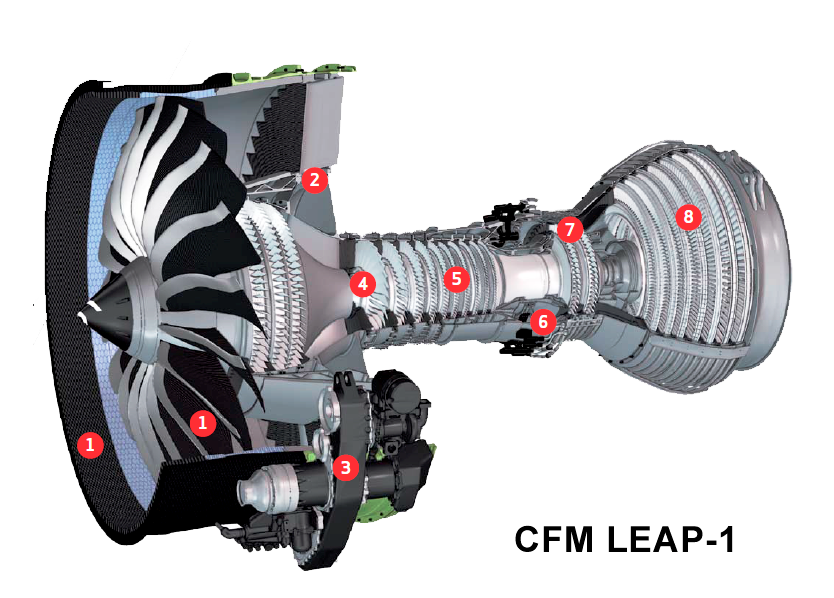Leeham News and Analysis
There's more to real news than a news release.
Farnborough: A320 engine suppliers roughly on recovery plan
July 19, 2018, © Leeham News, Farnborough: The engine suppliers for the Airbus A320 family are roughly keeping to their  recovery plan designed to catch up late deliveries and fix technical problems, a top official said this week.
recovery plan designed to catch up late deliveries and fix technical problems, a top official said this week.
Guillaume Faury, is the new president and CEO of the Airbus Commercial unit in Airbus Group.
“We look at short-term, medium- and long-term. Short-term, we had an H1 (first half) that was OK for all programs, but the single-aisle was a difficulty with all the engines. We will have a very strong H2 and this is obviously very high on my agenda.
Pontifications: Engine problems are getting worse
May 14, 2018, © Leeham News: The engine problems are getting worse.
These have moved beyond the technical issues with the Rolls-Royce Trent 1000, GE Aviation GEnx, Pratt & Whitney GTF and CFM56.
The problems are trickling down to the maintenance, repair and overhaul shops.
LNC previously touched on the back-up in MRO shops due to the RR Trent 1000 problems, affecting even Trent 700 (Airbus A330) MRO scheduling. We’ve also reported the knock-on effect of the GTF MRO on other engine shop visits.
The mandated-inspections of CFM56 fan blades in the wake of the Southwest Airlines accident last month inundated MRO shops with unexpected visits.
Now, a European appraisal company forecasts that the “bow wave” of CFM56 shop visits will create a crisis for spare engines and parts.
Demand supports rate 70/mo for A320, 737
Subscription Required
Introduction
May 3, 2018, © Leeham Co.: With the supply chain confirming last Thursday that Airbus and Boeing are exploring single-aisle production rates of 70/mo, Airbus confirmed it was doing so during its Friday earnings call.
 Boeing continues to be ambiguous, saying only there is “upward pressure” on its 737 production rates.
Boeing continues to be ambiguous, saying only there is “upward pressure” on its 737 production rates.
The supply chain, notably the engine OEMs, already has heartburn over the current rate of 60/mo and 52/mo for the A320 and 737 families respectively.
Summary
- Engine makers CFM and Pratt & Whitney continue to have technical and production issues.
- Airbus and Boeing each have “gliders,” though Boeing’s is a handful vs the dozens at Airbus.
- CFM’s partner, Safran, cautions against rate 70.

Production rates will be among the topics at the Southeast Aerospace & Defence Conference next month in Mobile (AL). Click here for more information.
Engine makers may face stiffer future ETOPS certification requirements
Subscription Required
Introduction
April 23, 2018, © Leeham News: Even before last week’s Southwest Airlines accident raised the focus on aircraft engines, industry officials were becoming worried that problems with engines powering the Boeing 747-8, 787, 737 MAX and Airbus A320neo may lead to stricter certification standards by regulatory authorities.
There is also emerging evidence that the issues with the Rolls-Royce Trent 1000 on the 787s may negatively impact Airbus’ sales efforts with the A350. The A350 is powered by an entirely different RR engine, the Trent XWB, which by all accounts has had a virtually trouble-free entry into service.
powered by an entirely different RR engine, the Trent XWB, which by all accounts has had a virtually trouble-free entry into service.
But it’s a Rolls-Royce engine and airlines affected by or watching RR’s response to the Trent 1000 problems are skeptical about the Trent XWB, LNC is told.
Summary
- How long will it take for the FAA and EASE to restore full ETOPS for the 787?
- Concerns emerge that regulators may be more restrictive of ETOPS for new engines powering new planes, with the Boeing 777X next up.
- Impact seen on reception of Rolls-Royce engines on Airbus A330neo and A350.
- What do the engine problems mean for the Boeing NMA?
Pontifications: Uncontained engine failures are rare but not unknown
April 23, 2018, © Leeham News: Last week’s engine malfunction on a Southwest Airlines Boeing 737-700 was another in a rare, but not unknown, uncontained engine anomaly in recent years.
All recent similar failures didn’t cause a loss of life or serious injuries if the passengers were evacuated. Unfortunately, this accident caused one fatality and seven injuries.
Let’s put the context to this issue.
Narrowbody and Widebody engine developments, Part 2
By Bjorn Fehrm
Subscription Required
Introduction
April 19, 2018, © Leeham News: In an article last week, we discussed the reason the new narrow-body engines are catching up to the fuel consumption of the wide-body engines.
Today we dig a bit deeper into the efficiency changes of the different engines and discuss which parameter changes have caused what changes in engine efficiency.
 We will use our engine modeling software GasTurb to analyze what happens in a Turbofan when we change certain parameters.
We will use our engine modeling software GasTurb to analyze what happens in a Turbofan when we change certain parameters.
Summary:
- The engine’s Core or Thermal efficiency changes with Turbine Entry Temperature (TET).
- To fully utilize such an increase in efficiency we need to adapt the overall design of the engine.
Déjà vu all over again
Subscription Required
Introduction
 April 16, 2018, © Leeham News: There’s high turnover in the executive ranks. Major delivery delays cause disruption and unhappy customers. Airlines are cancelling and switching orders. Product strategy is challenged. Your competitor is taking advantage and making significant inroads.
April 16, 2018, © Leeham News: There’s high turnover in the executive ranks. Major delivery delays cause disruption and unhappy customers. Airlines are cancelling and switching orders. Product strategy is challenged. Your competitor is taking advantage and making significant inroads.
If this sounds familiar, it is.
It’s déjà vu all over again.
Narrowbody and Widebody engine developments
By Bjorn Fehrm
Subscription Required
Introduction
April 12, 2018, © Leeham News: In an article yesterday about Long-Haul LCC costs we observed how the new Narrowbody engines are catching up to the fuel efficiencies of the Widebody engines.
Traditionally the Widebody engines were the efficiency leaders. The Narrowbody companions were designed to be durable rather than efficient.
We use the engine modelling software GasTurb to understand why this catching up of the Narrowbody engines has happened.
Summary:
- The new Narrowbody engines for Airbus’ A320 series and Boeing’s 737 MAX are close in specific fuel consumption to the new Widebody engines.
- We use the GasTurb engine modelling software to find the root cause of this change.
Focus on NMA engines: all OEMs vying for Boeing’s approval
Subscription Required
Now open to all readers.
Introduction
March 22, 2018, © Leeham Co.: As Boeing enters the final stretch whether to launch the New Midrange Aircraft (NMA, aka 797) market focus should shift to the  engines more than the airframe and even the market demand.
engines more than the airframe and even the market demand.
It all comes down to this: no engines, no plane.
Monday’s post outlined some of the issues to consider.
But there are larger implications as well.
Summary
- Market sources are tossing about various scenarios about the future GE Aviation and CFM.
- Rolls-Royce won’t have its Trent 1000 problems fixed until 2021 or 2022, at great cost.
- Pratt & Whitney won’t have its Geared Turbo Fan final PIP packages for its problems sorted out until around 2021.
- Resources—both financial and with engineering—are stretched now.
- Sequencing current engine problems, and in the case, GE’s GE9X, are a factor, in the eyes of some.




